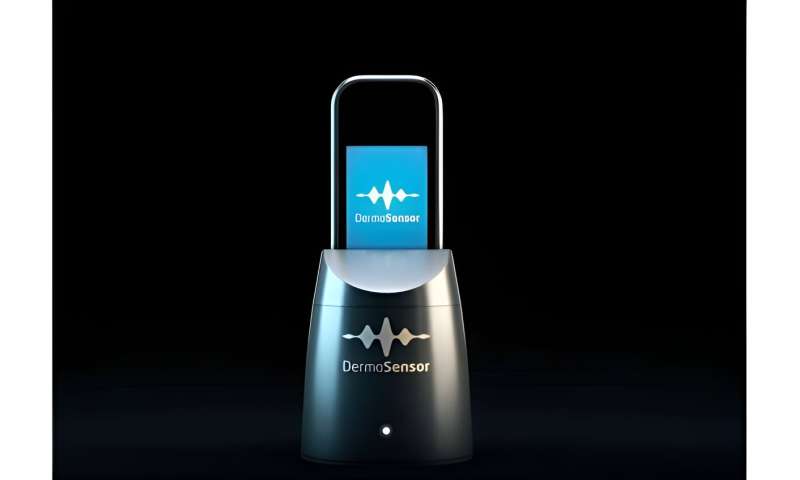Innocent mole or skin cancer? FDA clears device that makes detection easier

Maybe it's just a funky-looking, unique-to-you mole. But that irregular patch or evolving mark could signal bad news: skin cancer, the most common form of cancer in the United States. Although spotting skin cancer early could save your life, it can be tough for even some medical professionals to judge if a mark is benign or potentially harmful.
A new noninvasive skin cancer detection device—powered by technology pioneered by a professor at Boston University's College of Engineering—aims to make telling the difference easier and faster.
The US Food & Drug Administration recently cleared for US markets DermaSensor, which uses light and artificial intelligence to examine skin lesions and assess whether a patient should be referred to a specialist. The company bringing the handheld device to market says it has the potential to slash the number of missed skin cancers by half.
DermaSensor's underlying sensing technology, elastic scattering spectroscopy (ESS), was developed and refined by Irving J. Bigio, an ENG professor of biomedical engineering and of electrical and computer engineering. He's a scientific advisor to the eponymous company behind the device, which also licensed patents from Bigio and BU.
"The FDA had designated this as a breakthrough technology, which means they gave it higher priority for review because they see it as having a real impact," says Bigio. "And the trials showed that it actually does work."
Bigio says DermaSensor's clearance doesn't just reflect well on his Biomedical Optics Lab, but also on BU's cross-disciplinary approach to fostering new technologies.
"It's a positive statement about BU's commitment to interdisciplinary research that involves the engineering and physical sciences, as well as the medical school," says Bigio, who also holds positions in BU's Chobanian & Avedisian School of Medicine and physics department. "They are supportive of collaborative research across schools."
According to the American Academy of Dermatology Association, one in five of us will grapple with skin cancer at some point in our lives, which is why it recommends regular skin exams.
In its pivotal FDA study—the research that makes or breaks a new clinical technology—DermaSensor says researchers found the device had "a sensitivity of 96% across all 224 skin cancers." It can detect the most frequent forms of skin cancer—basal cell carcinoma and squamous cell carcinoma—and the less common, but more deadly, melanoma.
Bigio first began working on ESS as a senior research scientist in New Mexico at Los Alamos National Laboratory, and continued to advance it when he joined BU in 2001. An optical technique, ESS involves directing pulses of light at tissue, then scrutinizing which colors of light bounce back to reveal important information about cellular and subcellular structures.
In the case of DermaSensor, the light can reveal whether tissue is potentially cancerous, as malignant and benign lesions scatter light differently. Bigio says it works equally well on different skin tones.
"The word elastic means that the light scatters but doesn't change its wavelength; on the other hand, how efficiently it scatters and in what direction it scatters does depend on the wavelength," says Bigio. "And that wavelength dependence is informative about the size and density of the microscopic structures in the tissue."
In the clinic, a physician or nurse puts the tip of the DermaSensor on a lesion. The device then fires off a pulse of light and analyzes the spectral information of the backscattered light using an AI-powered algorithm. Eladio Rodriguez-Diaz (ENG'09), a former Ph.D. student in Bigio's lab, developed much of the sensor's machine learning and data analysis technology; he's a coinventor on some of the patents.
"It's incredibly gratifying to see Dr. Bigio's innovative research incorporated into an FDA-cleared medical device, especially one with the potential to noninvasively detect skin cancer," says Frances Forrester, director of business development in BU Technology Development. "Early detection is known to save lives, and now a new tool is available to US-based primary care providers and their patients through BU research."
According to Bigio, many potentially cancerous lesions are currently missed in primary care clinics—something DermaSensor could help change. He gives the scenario of a patient who spots a concerning mark on their body and asks their doctor to take a look.
"If it looks suspicious, they'll send the patient to the dermatologist, but of patients who are referred to the dermatologist, only 1 out of 18 to 20 actually have cancer, or precancer," says Bigio. "But of the patients who present in the primary care setting who actually have skin cancer, only half are currently being referred."
Bigio says the device is the first consumer-facing medical product using ESS to hit the market, but that he and his clinical collaborators have spent decades testing the technology's potential in other fields. In multiple studies they've shown it could help pinpoint the locations of tumors, measure the effectiveness of cancer medications, detect malignant thyroid nodules, and differentiate normal from abnormal polyps during a colonoscopy.
In some cases, he says, that research is ready to make the jump from the bench to the bedside—they just need to find the right commercial partners to take things to the next level, as DermaSensor has done.
"I think the DermaSensor success in getting FDA clearance, and some initial commercial success that I'm quite confident is going to come now, will be the rising tide that floats other boats," says Bigio. "Once investors or med tech companies see this, they're going to take a stronger interest. And we're already starting to see that in what we've been doing for interventional radiology and intravital measurements in various organs."
Provided by Boston University